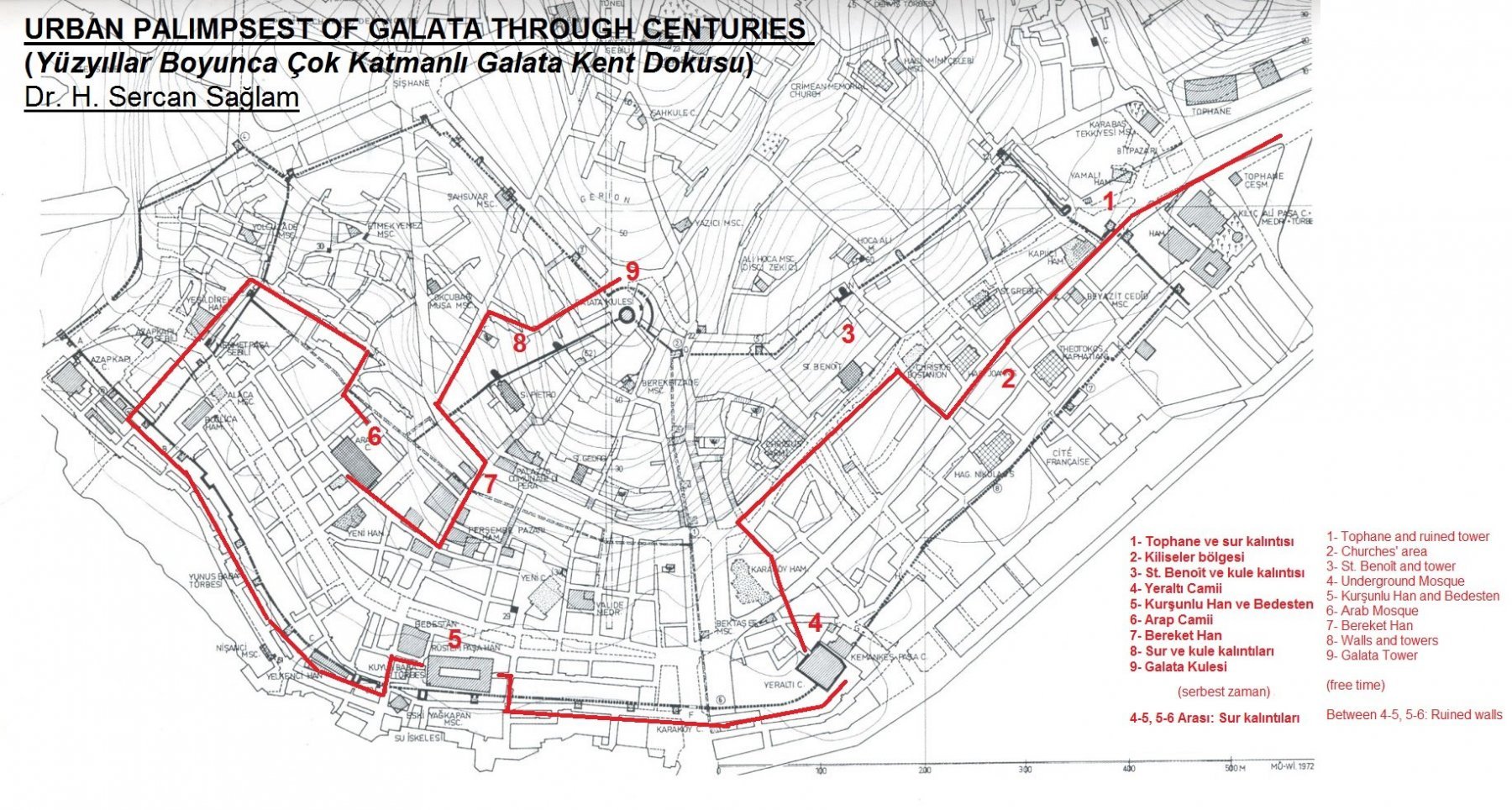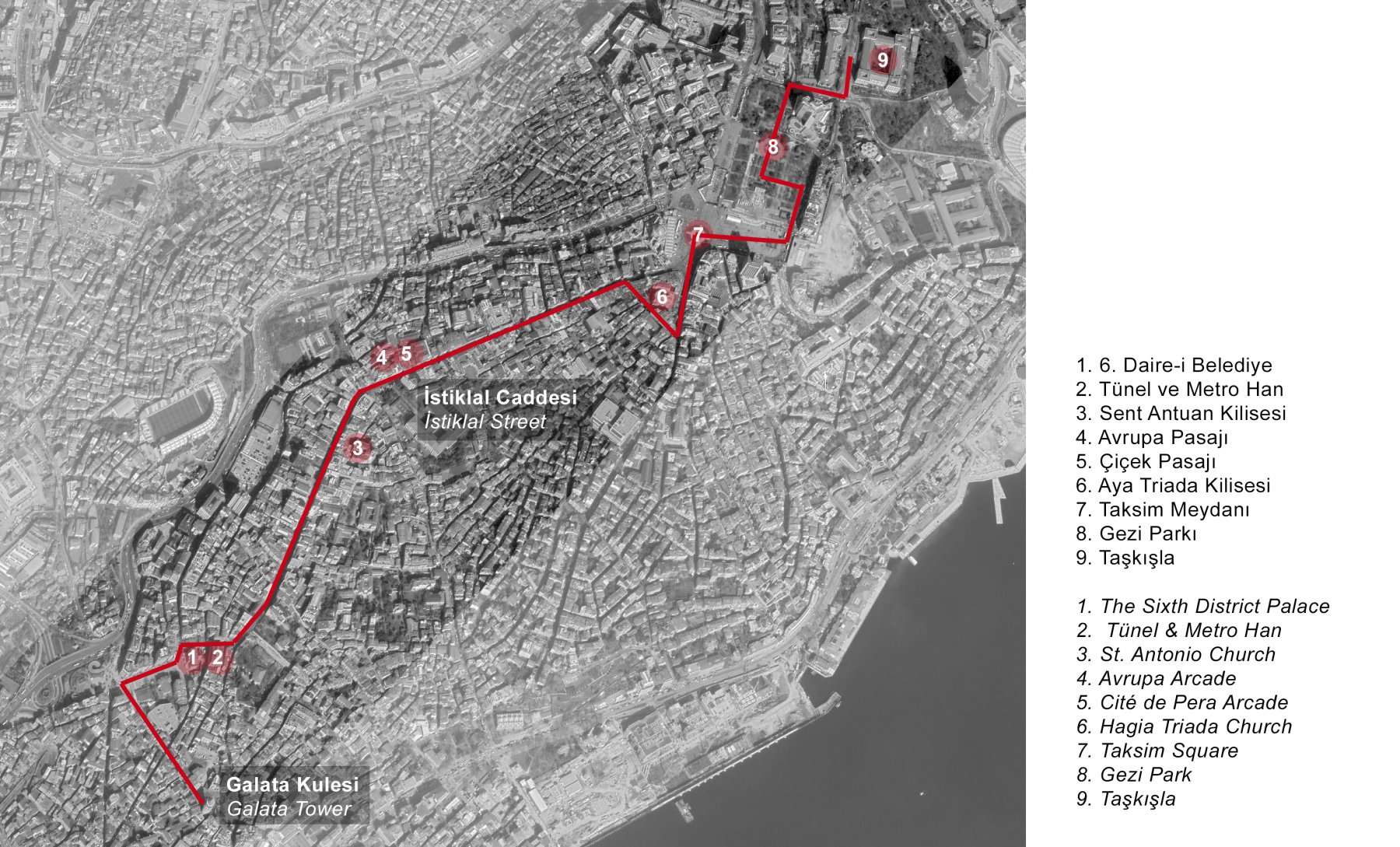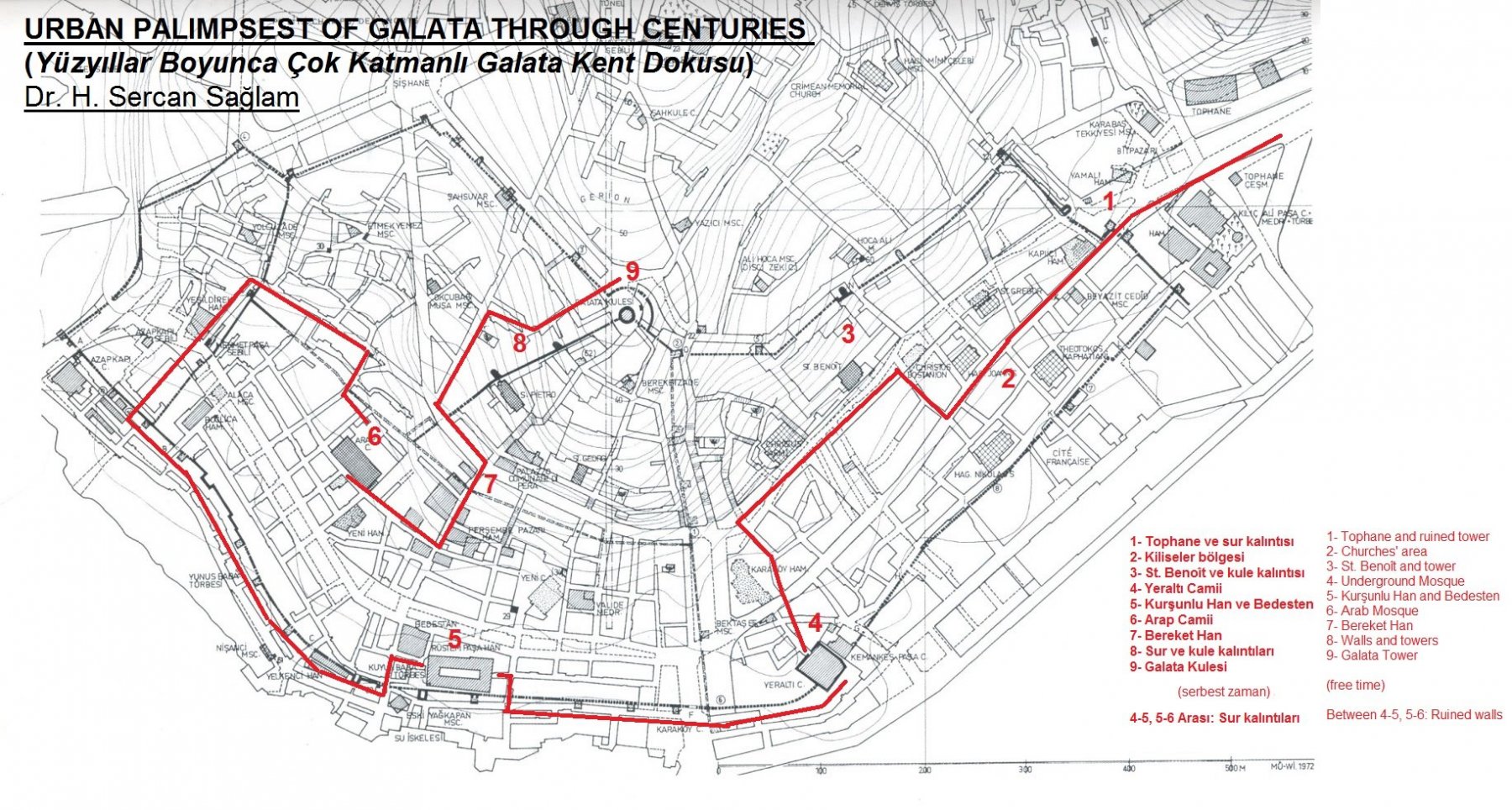Galata - Beyoglu
Western Face of Ottoman Capital - Urban Palimpsest of Galata Through Centuries
Urban Palimpsest of Galata Through Centuries
Guide
Dr. H. Sercan Sağlam

As one of the most important suburbs of Istanbul, Galata had significant urban developments during its Byzantine, Genoese and Ottoman periods, therefore an urban and architectural stratification has occurred. It is still possible to observe this multilayered city pattern. For instance, Tophane (cannon foundry) was established by Mehmed II in front of a portion of Galata Walls built around 1445 (1). After passing this foundation, there is an area of churches, which reflects the historical multiethnic social structure of Galata. Although those neighboring church buildings had overall reconstructions during the 19th and 20th centuries, their origins date back to the Genoese period of Galata (2). St. Benoît is originally a Late Byzantine church, which was occupied by the Benedictines in 1427 and had many repairs especially due to devastating fires through centuries. A Genoese tower from the mid-14th century is located in its garden (3). Similarly, Yeraltı Camii (Undergound Mosque) is actually an Early Byzantine castle, which had noteworthy architectural and functional changes during Genoese and Ottoman periods (4). Rüstem Pasha Caravanserai and the Bedesten had formed the commercial heart of Galata during its Classical Ottoman period. These monuments were constructed on plots formerly occupied by some Genoese and Byzantine period monuments, which were later disappeared (5). Arab Mosque is undoubtedly the best example to display the multilayered structure of Galata. With its position and architecture, it reflects the rich and intertwined Byzantine, Genoese and Ottoman periods (6). The communal palace (Palazzo Comunale) was the administrative center of the Genoese Galata and it was erected in 1316. It turned into Bereket Han after some mid-19th century demolitions and alterations (7). Perhaps the best preserved part remained from Galata Walls is located behind the church of Ss. Pietro e Paolo. It was constructed in the mid-14th century and consisted of two semicircular towers with surrounding ramparts (8). Galata Tower was constructed in 1348 by the Genoese but especially its upper parts had successive restorations by the Ottomans (9). It is possible to encounter with minor remnants from Galata Walls in the middle of the modern urban fabric, which are forgotten in time (4-5, 5-6).
Western Face of Ottoman Capital
Beyoğlu / Grande Rue de Pera
Guide
Ebru Şevkin

Beyond the Galata walls, the Pera region, which was composed of vineyards and orchards, had started to be built up gradually from the middle of the 18th century. Following the increasing relations with Europe, this area became the western face of the Ottoman capital representing a very different urban character comparing to the walled city across the Golden Horn. The mansions exhibiting the wealth of its mostly foreign inhabitants, embassies, hotels, theatres, coffee houses, department stores selling European goods, offices and churches were situated at the area especially along the main axis called Grande Rue de Pera (İstiklal Street). The buildings mostly represented the Neoclassical and eclectic style, which were aligned with the European flavour dominating this part of the city. In the Republican Era the design of the Taksim Square with its Republican Monument brought a new significance to the area. The square where the most official ceremonies are held became one of the most important public places in the city.
1. The Sixth District Palace
As a part of the modernization efforts, the first municipal organization for the city of Istanbul was established in 1856. The city was divided into 14 districts. The Sixth Municipal District comprising Galata, Beyoğlu and Tophane, where most of the wealthy foreign population lived, established as a pilot area. The first municipal building, The Sixth District Palace, was constructed in Beyoğlu. The Neoclassical building designed by an Italian architect Giovanni Battista Barborini was built between 1879-1883.
2. Tünel & Metro Han
Tünel is an underground funicular railway connecting Galata to Karaköy. It was designed and constructed by French engineer Eugéne-Henri Gavand and opened in 1875 as the world’s second underground railway. Over the entrance of the Tünel is the Metro Han, a seven storey steel-framed Neoclassical building constructed in 1913 with two extra floors added in the 1930s.
3. St. Antonio Church
The church was built for the Genoese and Venetian communities lived nearby. The Venetian Neo-gothic style of the building represents these communities. The building was designed by an Italian architect Guilo Mongeri and built between 1906 and 1912 as one of the first concrete buildings in Beyoğlu. The project comprised a church and an apartment building that provides an income for the maintenance of the church.
4. Avrupa Arcade
Although the covered streets were familiar in İstanbul, the glass roof covering and the overall architectural style of these arcades built in the Beyoğlu in the 19th century were new for the city. Avrupa Arcade, also called Mirrored Arcade, was built in the place of the former Naum Theatre between 1874 after the Beyoğlu fire of 1870. The Neoreneissance style arcade has shops on the each side of the corridor.
5. Cité de Pera Arcade
The arcade was commissioned by banker Christaki Zografos and built between 1874 and 1876 by Cleanthe Zanno. It has an eclectic design with Baroque and Neoclassical ingredients.
6. Hagia Triada Church
The Greek Orthodox Church of Hagia Triada was designed by Vasaliki Ioannidis and completed in 1880. The church has a cruciform plan. The dome marks the crossing and two bell towers are placed at the each side of the dome. Its architectural design combines Byzantine, Neoclassical, Renaissance and Baroque elements.
7. Taksim Square
It takes its name from the structure that distributes water to Galata and Pera, dating back to the reign of Sultan Ahmet III, called “maksem”. The sqaure was designed in the 1920s, in the Republican Period. The monument located at the heart of the square belongs to Italian sculptor Pietro Canonica and the landscape design belongs to Gulio Mongeri. It was erected in 1928 to commemorate the foundation of the Turkish Republic.
8. Gezi Park
In the mid-1930s French urban planner named Henri Prost was appointed as the Chief Planner for İstanbul. The first major project in Taksim according to Prost’s plans was the demolition of the Artillery Barracks to create a public promenade. The demolition made way for the construction of a modern park and promenade named after İsmet İnönü as İnönü Gezisi (İnönü Promenade). The project was accompanied by a new park (Maçka Park) a football stadium and an open air theatre.
9. Taşkışla
The building was designed as a medical academy for the Ottoman Army in the Sultan Abdülmecit’s reign. During the construction the plans were modified and the building finished as a military barrack in 1853. The design of the building, by English architect William James Smith, represents a Neoreneissance character. In the 1940’s Emin Onat and Paul Bonatz modified the building to serve as part of the Istanbul Technical University.
Urban Palimpsest of Galata Through Centuries

Guide
As one of the most important suburbs of Istanbul, Galata had significant urban developments during its Byzantine, Genoese and Ottoman periods, therefore an urban and architectural stratification has occurred. It is still possible to observe this multilayered city pattern. For instance, Tophane (cannon foundry) was established by Mehmed II in front of a portion of Galata Walls built around 1445 (1). After passing this foundation, there is an area of churches, which reflects the historical multiethnic social structure of Galata. Although those neighboring church buildings had overall reconstructions during the 19th and 20th centuries, their origins date back to the Genoese period of Galata (2). St. Benoît is originally a Late Byzantine church, which was occupied by the Benedictines in 1427 and had many repairs especially due to devastating fires through centuries. A Genoese tower from the mid-14th century is located in its garden (3). Similarly, Yeraltı Camii (Undergound Mosque) is actually an Early Byzantine castle, which had noteworthy architectural and functional changes during Genoese and Ottoman periods (4). Rüstem Pasha Caravanserai and the Bedesten had formed the commercial heart of Galata during its Classical Ottoman period. These monuments were constructed on plots formerly occupied by some Genoese and Byzantine period monuments, which were later disappeared (5). Arab Mosque is undoubtedly the best example to display the multilayered structure of Galata. With its position and architecture, it reflects the rich and intertwined Byzantine, Genoese and Ottoman periods (6). The communal palace (Palazzo Comunale) was the administrative center of the Genoese Galata and it was erected in 1316. It turned into Bereket Han after some mid-19th century demolitions and alterations (7). Perhaps the best preserved part remained from Galata Walls is located behind the church of Ss. Pietro e Paolo. It was constructed in the mid-14th century and consisted of two semicircular towers with surrounding ramparts (8). Galata Tower was constructed in 1348 by the Genoese but especially its upper parts had successive restorations by the Ottomans (9). It is possible to encounter with minor remnants from Galata Walls in the middle of the modern urban fabric, which are forgotten in time (4-5, 5-6).
